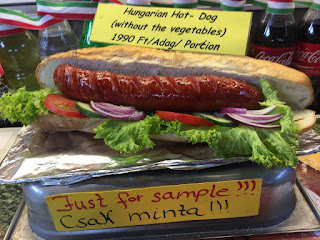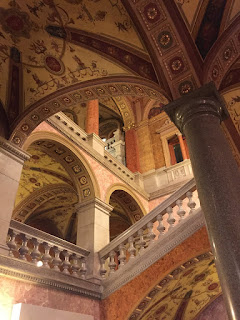Parliament Building in Budapest at night
We strolled across the Chain Bridge and looked into the magnificent lobby of the 5 star hotel in the Gresham Palace. We wandered around the streets and stood admiring St. Istvan's Basilica as the sun set. There was a festival going on in many of the squares around the city so we wandered through the crowds observing. On the spur of the moment, we decided to ride on the Prague Eye which is called the Island Eye. It revolves high above the city so the lit buildings are spectacular. The next day we decided to visit the Jewish Quarter. There was a huge Jewish community in Hungary (450,000) and 200,000 lived in Budapest before WW II. The Nazi's didn't start deporting the Jews until 1944. By the end of the war, the largest percentage of Jewish victims came from Hungary. The most imposing structure connected to the Jews in this city is the Great Synagogue which actually was appropriated as the main Nazi office in this city because they knew the Allies would not bomb it.
Exterior of the Great Synagogue
Pulpit (!) in the Great Synagogue
Interior of the Great Synagogue
It doesn't look like a traditional synagogue. The Budapest Jews wanted to be part of the larger community so they had an architect who designed it to look more like a church. It even has a magnificent organ that was played by Franz Liszt when the building was dedicated. There was a small homegrown festival going on in the quarter and we strolled along with a lot of locals until we had to sit at a cafe and collect ourselves and try to cool off with lemonade and hummus. It does pose a challenge to walk and walk and walk in 95 degree weather so we smartened up and started hopping on and off public transit. It helps. At night, it cools down around 9 or 10 and then it is lovely stolling around the city that is lit up light a fairy tale.
The city is divided by the Danube River into two parts: Buda and Pest. The castle and St. Mattias' Church are on the hill on the Buda side. The Town Center, Jewish Quarter, and Leopold Town are on the Pest side.
The Castle Hill area is impressive, even though it was hotter than hot. We walked from the statue of the Turul Bird past the Royal Castle and Museums to Mattias Church. We walked through this impressive structure and climbed the towers to view the Ecclesiastical art. Outside the church there is a seven pointy domed structure called the Fisherman's Bastion with an incredible view of the city.
Turol Bird
Mattias Church
Fisherman's Bastian
As you might imagine, food is an important part of our tour. The countries we are visiting are primarily known for meat and potatoes and beer. We love the potatoes but aren't really big meat folks or drinkers either but we are doing our best to step up to the plate on the beer part. On the bike tour, the guides provided lots of salads and fruit and when we ate out, we were able to order things that worked for our tastes. Here, we decided to jump in and see what the Food Hall scene is like. We made the pilgrimage to the Great Market Hall and walked through three levels of food and souvenir vendors.
Market Hall
Pickled everything
We stopped to eat a freshly made Langos which is really kind of a fried bread with various toppings. We opted for the simple one with powdered sugar.
There was one iconic site we just didn't make it to. Budapest is known for its baths. There are several around the city and are supposed to be a must-visit. The trouble is that the temperature was 95 degrees and these are thermal baths. It just wasn't appealing. We will just have to return when it's cooler and try them then.
We have learned that we can't see everything a city has to offer and will just have to settle for what we can manage: touring the Opera House in all its baroque splendor, going to the New York Cafe full of gilt and mirrors built in 1894 for a drink and pastry, walking through Franz Lizst Square and along the shopping district along Andrassy Ut. We did not get to the many museums and squares chronicling Budapest's communist past.
New York Cafe
Interior of the Opera House
Vents under each seat at the Opera. The ducts lead to the Orchestra pit and made for great acoustics.
Budapest is a truly beautiful city with impressive architecture and culture. It's easy to see history in its squares and streets.


















No comments:
Post a Comment